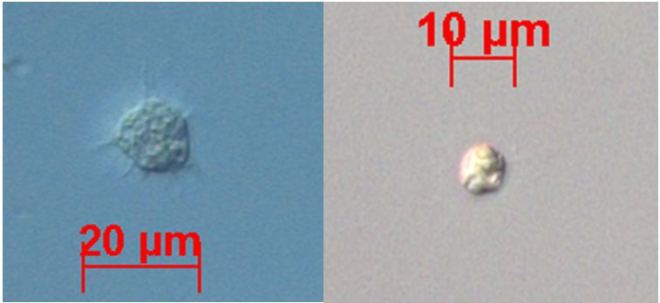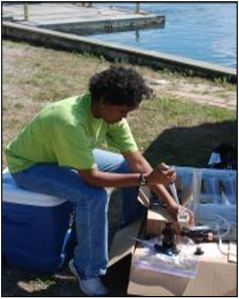Part three of an intermittent series on NOAA Fisheries’ Milford Laboratory, a federal facility that has been a leader in aquaculture research for over 80 years.

Blood may be thicker than water, but for oysters telling the difference takes a specialist – and that’s because shellfish blood is clear. Scientists usually refer to it as hemolymph (Greek for “blood water”) and it functions much like our own circulatory fluid, serving various purposes including nutrient transport, waste disposal, and cellular defense. Structurally though, hemolymph is less complex than human blood, having fewer (recognized) types of specialized cells, called hemocytes. And like our own blood cells, hemocytes are sensitive to environmental influences.
Dr. April Croxton, a bivalve physiologist at Milford, spends much of her time focused on understanding how environmental factors like temperature and water chemistry affect the immune responses of shellfish in Long Island Sound. Specifically, her area of particular interest is in the circulating cells responsible for immune responses in invertebrates, analogous to human white blood cells. These hemocytes defend the organism by first engulfing foreign particles like pathogens or pollutants and then internally degrading them by releasing molecules known as reactive oxygen species, or ROS*. Croxton’s work is oriented at assessing how hemocyte function is changed by influences that may stress shellfish metabolism.
One of Croxton’s past projects evaluated the effects of pollutants known as polycyclic aromatic hydrocarbons (PAHs), a class of compounds that are the mainly the products of fossil fuels or of burnt organic matter, on shellfish immune function. Prior research has shown that PAHs in the environment have detrimental effects on shellfish health. Eventually PAHs accumulate in sediment, where they are absorbed by seaweeds and microalgae which, in turn, become food for animals, including shellfish; Croxton wanted to establish whether or not PAHs could be transferred from sediment-dwelling microalgae to oysters and if so, whether or not this dietary PAH could have a negative influence on oyster health. Two sequential experiments revealed for the first time that exposure to increased dietary PAH from sediment-dwelling microalgae led to an increase in hemocyte counts and in ROS, meaning that the pollutants stimulate an immune response not unlike an acute inflammatory response in humans.

Croxton also has been studying the effects of decreased pH on hemocyte integrity in several shellfish species. In addition to regulating immune response, hemocytes also are important contributors to the shell-building process: without properly functioning hemocytes, shellfish wouldn’t be able to grow or regenerate their shells. Ocean acidification, the widespread decrease in pH seen in marine waters in recent years, is thought to have a similar effect on shellfish as osteoporosis does on humans: brittleness of the calcified material that supports and protects the organism. Croxton’s recent experiments exposing shellfish hemocytes to acidified solutions have shown that species differ in how well they cope with low pH; some struggle to maintain homeostasis, but others rebound rapidly and “in about 10 minutes they are able to return to their original (internal) pH” (as the papers are currently in preparation, she is keeping mum about the details).

Most recently, Croxton has been turning her attention to more fundamental aspects of bivalve immunology. “I’ve been working on a project where we’re trying to determine a baseline of immune competence in oysters in Long Island Sound to get an understanding of seasonal changes in these immune cycles. We understand that their biological systems have seasonal cycles, in other words, their immune systems will change based on temperature and other seasonal changes. But before we can understand how climate change (for example) might impact these species we first need to understand what the natural cycles are.”
Foundational research like this often doesn’t get the credit it deserves, since non-specialists can have a harder time picturing how it can be applied to real life uses. Croxton sums it up: “A functioning immune system is imperative to the survival of complex organisms. It’s important to measure the immune profiles of commercial and recreational species, which are natural resources, so that we understand how pathogens and other stressors could impact these species.”
*ROS are destructive byproducts of the mitochondrial conversion of sugar into energy and are the primary reason we take antioxidants to defend our cells. It happens that hemocytes are able to harness that destructive power as a defense mechanism.
Posted by Ken Hamel, Research Intern for CFE Save the Sound
References:
Croxton, A., & Wikfors, G. (2013). Intracellular pH Recovery Rates of Hemocytes from Estuarine and Open Ocean Bivalve Species Following In vitro Acid Challenge. In AGU Fall Meeting Abstracts Vol. 1, p. 1716.
Croxton, A. N., Wikfors, G. H., & Schulterbrandt-Gragg, R. D. (2012). Immunomodulation in eastern oysters, Crassostrea virginica, exposed to a PAH-contaminated, microphytobenthic diatom. Aquatic Toxicology, 118, 27-36.
Hégaret, H., Wikfors, G. H., & Soudant, P. (2003). Flow cytometric analysis of haemocytes from eastern oysters, Crassostrea virginica, subjected to a sudden temperature elevation: II. Haemocyte functions: aggregation, viability, phagocytosis, and respiratory burst. Journal of experimental marine biology and ecology, 293(2), 249-265.
